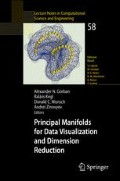We present a family of topology preserving mappings similar to the Self-Organizing Map (SOM) and the Generative Topographic Map (GTM). These techniques can be considered as a non-linear projection from input or data space to the output or latent space (usually 2D or 3D), plus a clustering technique, that updates the centres. A common frame based on the GTM structure can be used with different clustering techniques, giving new properties to the algorithms.
Thus we have the topographic product of experts (ToPoE) with the Product of Experts substituting the Mixture of Experts of the GTM, two versions of the Harmonic Topographic Mapping (HaToM) that utilise the K-Harmonic Means (KHM) clustering, and the faster Topographic Neural Gas (ToNeGas), with the inclusion of Neural Gas in the inner loop. We also present the Inverse-weighted K-means Topology-Preserving Map (IKToM), based on the same structure for non-linear projection, that makes use of a new clustering technique called The Inverse Weighted K-Means. We apply all the algorithms to a high dimensional dataset, and compare it as well with the Self-Organizing Map, in terms of visualisation, clustering and topology preservation.
Access this chapter
Tax calculation will be finalised at checkout
Purchases are for personal use only
Preview
Unable to display preview. Download preview PDF.
References
Arsuaga-Uriarte, E. and Daz-Martn, F.: Topology preservation in SOM. Trans-actions On Engineering, Computing And Technology, 15, 1305-5313 (2006)
2. Barbakh, W., Crowe, M., and Fyfe, C.: A family of novel clustering algorithms. In: 7th international conference on intelligent data engineering and automated learning, IDEAL2006 (2006)
3. Barbakh, W. and Fyfe, C.: Performance functions and clustering algorithms. Computing and Information Systems, 10 (2), 2-8 (2006) ISSN 1352-9404.
Bishop, C. M., Svensen, M., and Williams, C. K. I.: Gtm: The generative topo-graphic mapping. Neural Computation, 10 (1), 215-234 (1997)
5. Bishop, C. M., Svensen, M., and Williams, C. K. I.: Magnification Factors for the GTM Algorithm. In: Proceedings of the IEE 5th International Conference on Artificial Neural Networks, Cambridge, U. K., 64-69P (1997)
Friedman, J., Hastie, T., and Tibshirani, R.: Additive logistic regression: a statistical view of boosting. Annals of Statistics, 28, 337-374 (2000)
Fyfe, C.: Two topographic maps for data visualization. Mining and Knowledge Discovery (2007)
Dyrskjot, L., Thykjaer, T., Kruhoffer, M. et al.: Identifying distinct classes of bladder carcinoma using microarrays. Nat Genetics 33 (1), 90-96 (2003)
9. Hamerly, G. and Elkan, C.: Alternatives to the k-means algorithm that find better clusterings. In: CIKM ’02: Proceedings of the eleventh international conference on Information and knowledge management, pages 600-607, New York, NY, USA, ACM Press (2002)
Hinton, G. E.: Training products of experts by minimizing contrastive diver-gence. Technical Report GCNU TR 2000-004, Gatsby Computational Neuro-science Unit, University College, London (2000)
Jacobs, R. A., Jordan, M. I., Nowlan, S. J., and Hinton, G. E.: Adaptive mixtures of local experts. Neural Computation, 3, 79-87 (1991)
Jordan, M. I. and Jacobs, R. A.: Hierarchical mixtures of experts and the em algorithm. Neural Computation, 6, 181-214 (1994)
Kohonen, T.: Self-Organising Maps. Springer (1995)
Martinetz, T. M., Berkovich, S. G., and Schulten, K. J.: ‘neural-gas’ network for vector quantization and its application to time-series prediction. IEEE Transactions on Neural Networks., 4 (4), 558-569 (1993)
15. Neural Networks Research Centre. Helsinki University of Technology. Som toolbox. www. cis. hut. fi/projects/somtoolbox.
Peña, M. and Fyfe, C.: Developments of the generalised harmonic topographic mapping. WSEAS Transactions On Computers, 4 (11), 1548-1555 (2005)
Peña, M. and Fyfe, C.: Model-and data-driven harmonic topographic maps. WSEAS Transactions On Computers, 4 (9), 1033-1044, (2005)
18. Peña, M. and Fyfe, C.: The topographic neural gas. In: 7th International Con-ference on Intelligent Data Engineering and Automated Learning, IDEAL06., pages 241-249 (2006)
Tipping, M. E.: Topographic Mappings and Feed-Forward Neural Networks. PhD thesis, The University of Aston in Birmingham (1996)
Zhang, B.: Generalized k-harmonic means -boosting in unsupervised learning. Technical Report HPL-2000-137, HP Laboratories, Palo Alto, October (2000)
21. Zhang, B.: Generalized k-harmonic means-dynamic weighting of data in un-supervised learning. In: First SIAM international Conference on Data Mining (2001)
Zhang, B., Hsu, M., and Dayal, U.: K-harmonic means -a data clustering algo-rithm. Technical Report HPL-1999-124, HP Laboratories, Palo Alto, October (1999)
Author information
Authors and Affiliations
Editor information
Editors and Affiliations
Rights and permissions
Copyright information
© 2008 Springer-Verlag Berlin Heidelberg
About this paper
Cite this paper
Pena, M., Barbakh, W., Fyfe, C. (2008). Topology-Preserving Mappings for Data Visualisation. In: Gorban, A.N., Kégl, B., Wunsch, D.C., Zinovyev, A.Y. (eds) Principal Manifolds for Data Visualization and Dimension Reduction. Lecture Notes in Computational Science and Enginee, vol 58. Springer, Berlin, Heidelberg. https://doi.org/10.1007/978-3-540-73750-6_5
Download citation
DOI: https://doi.org/10.1007/978-3-540-73750-6_5
Publisher Name: Springer, Berlin, Heidelberg
Print ISBN: 978-3-540-73749-0
Online ISBN: 978-3-540-73750-6
eBook Packages: Mathematics and StatisticsMathematics and Statistics (R0)

